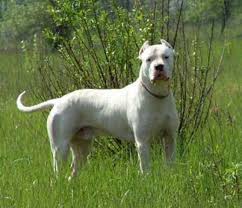
Córdoba fighting dog
Conditions of detention
Given their aggressive history, Córdoba Fighting Dogs were not suited for typical domestic living conditions. They required strong, secure environments with experienced handlers.
Useful Fact: These dogs were best kept in secure kennels or yards with high fences to prevent escape and reduce the risk of aggressive encounters.
Nutrition and diet
As strong and active dogs, Córdoba Fighting Dogs needed a high-protein diet to maintain their muscle mass and energy levels. Their diet would have been similar to other working dogs, focusing on meat and balanced nutrition.
Useful Fact: Regular, high-quality meals helped maintain their strength and stamina for the rigorous demands of fighting and training.
Health
The Córdoba Fighting Dog was known for its robust health, but like all breeds, it could suffer from common canine ailments such as joint issues and skin conditions. Regular veterinary care was essential.
Useful Fact: Their intense physical activity helped keep them in peak physical condition, but also necessitated careful monitoring for injuries.
Grooming and care
With a short coat, the Córdoba Fighting Dog required minimal grooming. Regular brushing helped remove loose hair and kept their coat healthy. Bathing was needed only occasionally.
Useful Fact: Their grooming routine was straightforward, focusing more on physical health and condition than on appearance.
Education and training
Training a Córdoba Fighting Dog required significant expertise due to their aggressive and independent nature. Training focused on obedience and control, using firm and consistent methods.
Useful Fact: Early socialization was crucial, though challenging, to mitigate aggressive tendencies and improve their ability to interact with handlers and other dogs.
Toys and entertainment
These dogs had high energy levels and needed physical and mental stimulation. Durable toys that could withstand rough play, such as strong chew toys and tug-of-war ropes, were suitable.
Useful Fact: Interactive toys that engaged their strong jaws and problem-solving abilities could help reduce boredom and channel their energy positively.
Safety
Safety was paramount with Córdoba Fighting Dogs due to their aggressive nature. Secure enclosures and careful handling were necessary to prevent accidents and injuries.
Useful Fact: Ensuring they were never left unattended with other animals or unfamiliar people was critical for safety.
Accessories
Sturdy collars, harnesses, and leashes were essential for handling. Providing durable bedding that could withstand their strength and potential chewing was also important.
Useful Fact: Using reinforced equipment helped prevent breakage and ensured better control during walks and training.
Socialization
Socializing a Córdoba Fighting Dog was particularly challenging due to their innate aggression. Early and consistent exposure to various environments, people, and controlled interactions with other dogs was necessary.
Useful Fact: Professional training and socialization programs were often required to manage their behavior effectively.
Travel and Transportation
Transporting these dogs safely required secure crates or specialized containment systems in vehicles. Acclimating them to travel from a young age helped reduce stress.
Useful Fact: Frequent breaks and careful supervision during travel helped manage their stress levels and prevent aggressive outbursts.
Behavior and psychology
The Córdoba Fighting Dog was bred for combat, resulting in a naturally aggressive and dominant temperament. They required strong, experienced handlers who could manage their behavior and provide proper training and socialization.
Useful Fact: Understanding their behavioral triggers and providing appropriate outlets for their energy were key to managing their aggressive tendencies.
Legal aspects
Due to their history as fighting dogs, owning a Córdoba Fighting Dog would have required adherence to strict regulations and laws. These regulations were designed to ensure public safety and responsible ownership.
Useful Fact: Knowledge of local laws regarding the ownership of aggressive breeds was essential for compliance and safety.


